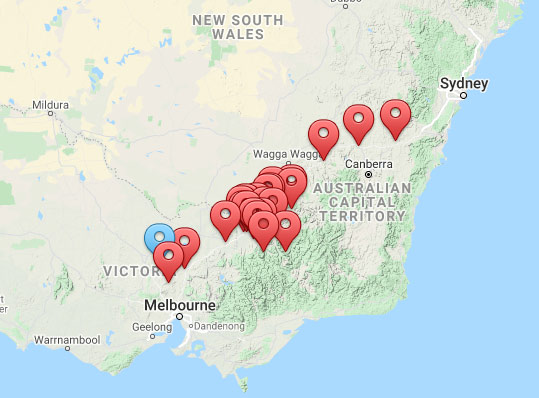Judge James Donnithorne (1773–1852) was in partnership with CH Ebden during the establishment of ‘Carlshrue’ station on the Campaspe River in the Macedon Ranges.
James Donnithorne (1773-1852), the son of Nicholas Donnithorne, was born and baptised in London. He grew up in London, where his father was a merchant and alderman. He joined the East India Company as a writer in 1792. He spent nearly forty years in the service of the Company. For many years, he was collector, mint master and officiating assay master at Farruckhabad, and later he was the salt agent and collector at Hidgelee. For a time, he was a judge and senior merchant in Mysore. In 1807, Donnithorne married Sarah Bampton, the daughter of a merchant seaman, Captain William Bampton (1759-1813), who had discovered the Bampton Reefs near New Caledonia in 1793. Sarah Donnithorne and two daughters died in a cholera epidemic in 1832. https://nla.gov.au/nla.obj-770255026/findingaid
Donnithorne came to New South Wales in 1836 on account of his health. He had amassed a fortune in India, and he immediately took up the position of a pastoralist, initially in partnership with Charles Ebden.
In the colony, he assumed, with little justification, the title of ‘Judge’. He acquired or leased extensive properties in New South Wales and South Australia. From 1840 to 1850, he was the owner of St Agnes Station, named after his birthplace, a vast estate lying between the Campaspe and Coliban rivers in the Port Phillip district. In Sydney, Donnithorne purchased Camperdown Lodge in Newtown. He was prominent in Sydney society and was well known for his hospitality. He was involved in numerous money-making schemes, becoming like another of his business partners, Charles Ebden, “disgustingly rich” in the process. https://yallambie.wordpress.com/tag/james-donnithorne/
Judge James Donnithorne was once described as,” he had a liver the size of a dinner plate and was in a perpetual state of near explosion,” (newspaper article about his daughter being jilted at the altar) https://trove.nla.gov.au/newspaper/article/161619602
Regarding Carlshrue station – ‘This was the complex sold early in 1843 to T.A. Gibbon, who obtained a licence as the Carlsruhe Inn. Rural inns were commonly run as a farm, not only to have fresh food on hand, but to supply fodder or pasture for travellers’ horses. The later history of Carlsruhe is included in the section on Towns. St. Agnes:· At the dissolution of his partnership with Ebden, James Donnithorne, with Stuart Donaldson, took over the leasehold right to all the run north of the Carlsruhe fence. It extended for eight miles along both sides of the Campaspe. A dray and bullock team, two horses, a cart and sundries and 8,925 sheep went with the run. So too did William Ward as overseer for the new run, which included all the former outhuts for shepherds. During 1840-41 Ward spent more than one thousand pounds in building a very good woolshed, house comprising sitting room, bedroom, 11 a room in the passage and a store and storekeeper 1 s room 11 • There was a kitchen hut, as well as quarters to house up to 22 station workers, some with wives and children. Fresh provisions came from an extensive, properly fenced kitchen garden. However, with wool prices at an unprofitable low in the bad times of the early 1840s, Ward was dismissed and supervision vested in Alexander Mollison, who was running cattle on his run Colliban to the north and sheep on Pyalong to the south-east. Some boiling down of sheep to make tallow was done before wool prices began to rise.’ file:///C:/Users/ISOCOG-009/Downloads/Volume-2-%E2%80%93-Background-History-PDF-29MB.pdf
Montmorenci Estate, Port Phillip – In the 1840s, the land was sold to Judge James Donnithorne (1773-1852) who ran the farm through Managers. He never lived there. On his death, the property was left to his daughter Elizabeth E. Donnithorne. Prior to her father’s death, Elizabeth E. Donnithorne (1826-1886), who was engaged to be married, was jilted at the altar. She lived the remainder of her life (approximately 35 years) as a recluse in New South Wales. Charles Dickens’s Miss Havisham, in his book Great Expectations, is said to be based on Elizabeth’s life. https://victoriancollections.net.au/media/collectors/4f729f5697f83e03086015b8/items/508114df2162ef09b47e11b6/item-media/508119b32162ef09b47e14b4/original.pdf


